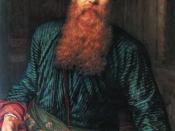Symbolism, Gender Relationships & Sexual Hypocrisy in Victorian Art.
An examination of William Holman Hunt's The Awakening Conscience & Félicien Rops' Pornokrates.
Two works of art completed with in 25 years of each other but both portraying exceptionally different ideas and values of social morality and gender relationships. By examining William Holman Hunt's The Awakening Conscience[ ] and Félicien Rops' Pornokrates[ ] in relationship to the social and moral issues of the Victorian era, of which they were completed in, this essay seeks to identify the reasons for the difference in gender relationships portrayed in these art pieces.
Sexual and moral values are always changing. During the Enlightenment of the 1700's women enjoyed a time where they could attain power and property, they were not thought to be the same as men, they simply required that they be treated with the deference and respect that was their due as women[ ].
As time wore on and the Victorian era came about there was an incredible and distinct change in morals and values towards women. Women were now submissive and inferior to their male counterparts, dependant upon men to the point where a woman was considered the property of man. A popular subject that emerged across all art forms of this time was that of the Fallen Woman. This is clearly represented in the abundance of literature produced at the time portraying main female characters as Fallen[ ]. This view of women persisted until what is referred to by fashion historians as the late or high bustle period which began in the 1880's. Of course we first see the change in these standards among the lower classes but by the early 1900's the idea of women as Femme Fatale had gained popularity to the point where even respectable...



Excellent!!!!
Very interesting, I think it is an excellent essay and you did deserve 95%. I enjoyed reading it!
6 out of 6 people found this comment useful.